MonoBeads: Purification of Milligram Quantities with Highest Resolution
Use MonoBeads for purification of proteins, peptides or oligonucleotides.
Use MonoBeads for polishing steps at laboratory scale when highest resolution is essential and a higher capacity than MiniBeads is required.
Use MonoBeads for capture or intermediate purification when milligram quantities are required, when there is no requirement for scale-up and/or when prepacked MiniBead columns do not offer sufficient capacity. Note that, to avoid column blockage, it is especially important to remove particulate matter before using MonoBeads.
Run MonoBeads on systems such as ÄKTAdesign, FPLC System and HPLC. Appendix 4 gives guidance on how to select the most suitable ÄKTAdesign system.
Mono Q and Mono S ion exchange media are based on a hydrophilic matrix made from monodispersed, rigid, polystyrene/divinyl benzene particles, substituted with quaternary ammonium (Q) or methyl sulfonate (S) groups (Figure 32). This combination confers extreme chemical and physical stability to the media. The small particle sizes (10 μm) allow fast binding and dissociation to facilitate high resolution while the uniformity of the particles ensures high flow rates at low back pressures. The strong ion exchange groups (Q and S) maintain their charge over a broad pH range Figure 33, allowing selection of the most suitable pH for each application.
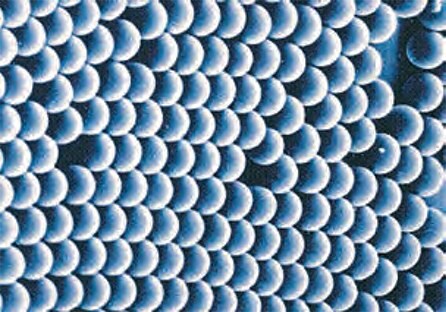
Figure 32. Electron micrograph of MonoBeads showing their distinct monodispersity.
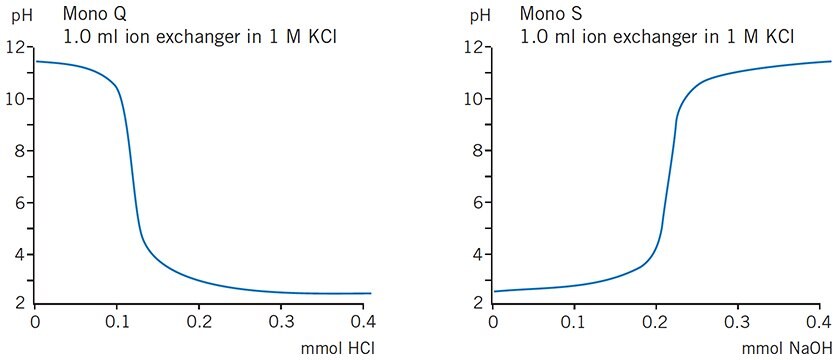
Figure 33. Titration curves for Mono Q and Mono S™. Binding capacity remains constant over a broad pH working range.
Purification options
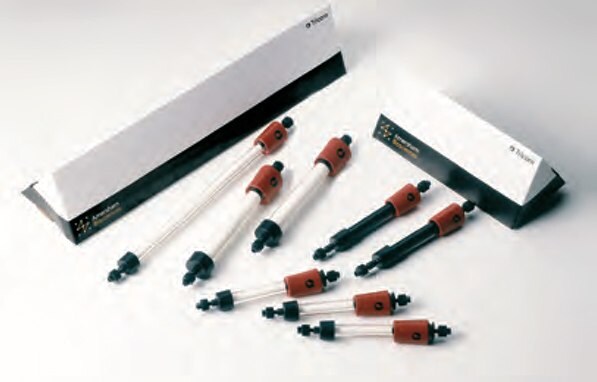
Figure 34. MonoBeads (Q and S) are available prepacked in Tricorn PE (PEEK) and Tricorn GL (glass) columns.
*Working pH range refers to the pH interval where the medium binds protein as intended or as needed for elution without adverse long term effects.
**Maximum operating back pressure refers to the pressure above which the medium begins to compress.
Purification examples
Two step purification using complementary selectivities
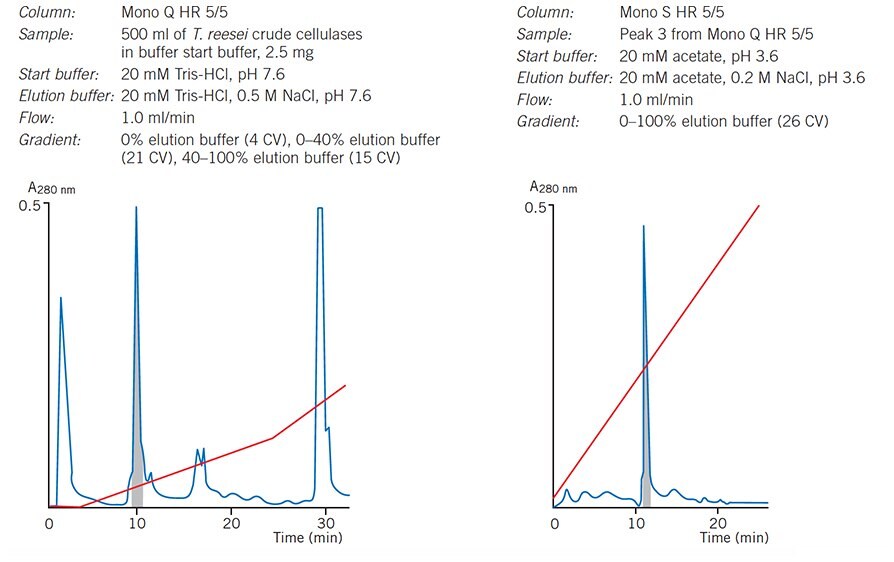
Figure 35. Purification of cellulose on Mono Q and Mono S HR 5/5 columns (now available as Mono Q 5/50 GL and Mono S 5/50 GL).
High resolution, polishing step
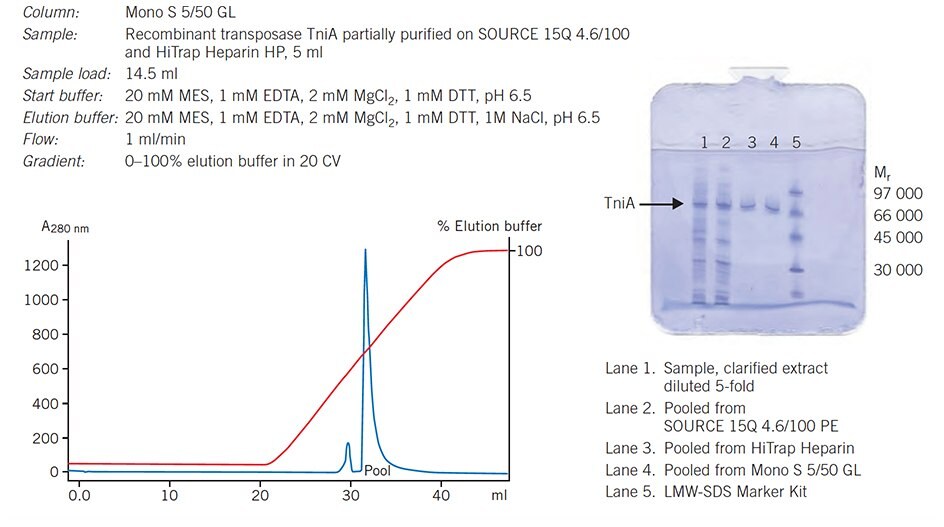
Figure 36. Final polishing step in purification of a DNA binding protein, transposase TniA. Two well-resolved peaks after separation on Mono S 5/50 GL (a). SDS-PAGE analysis shows fractions from each of the three steps used in this protocol (b), PhastSystem™ using SDS-PAGE PhastGel™ Homogenous – 12.5 and Coomassie™ staining.
Long term reproducibility
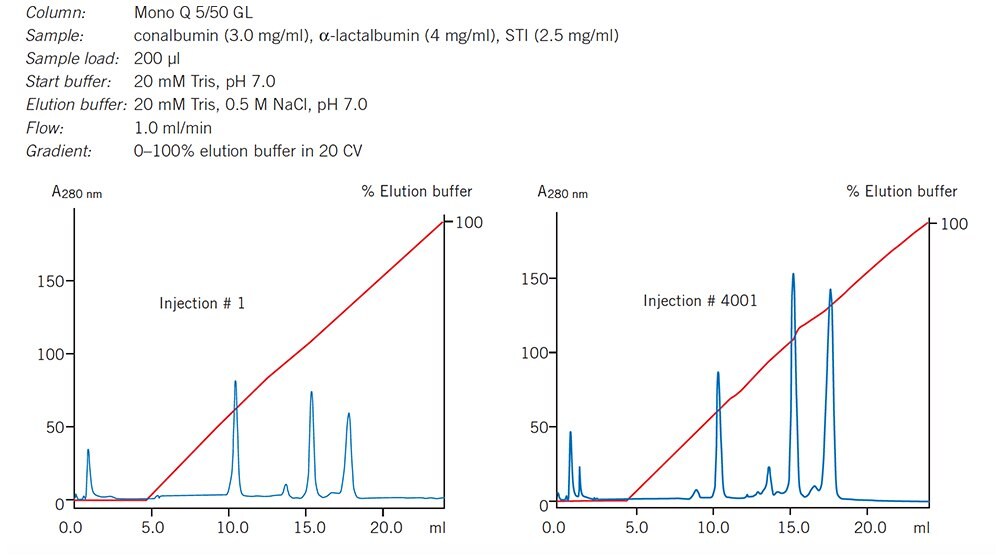
Figure 37. Chromatograms illustrating run to run reproducibility for Mono Q 5/50 GL (Tricorn). Runs 1, 1000 and 2000 are shown.
Separation in organic solvents
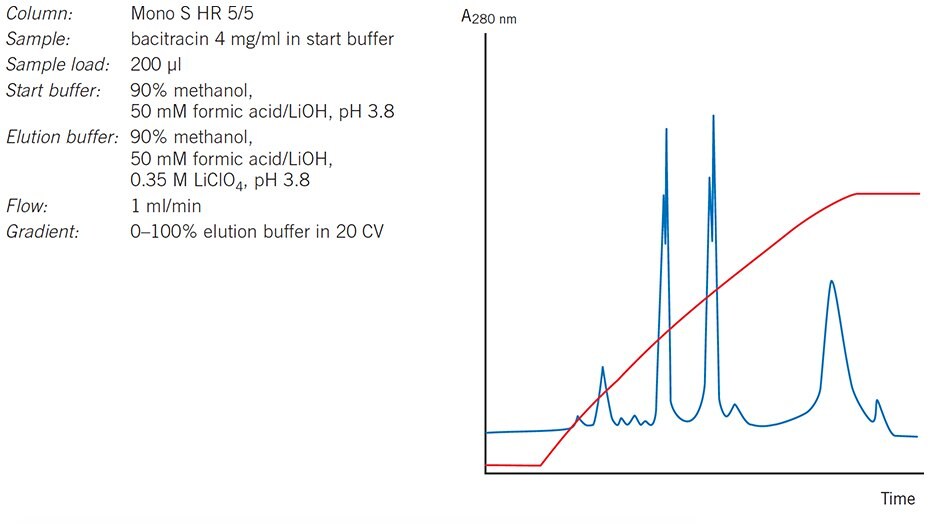
Figure 38. Separation of the peptide bacitracin on Mono S HR 5/5 (now available as Mono S 5/50 GL).
Performing a separation
Guidelines for selection of media, buffer, pH and ionic strength conditions and method optimization are given in Chapter 2. Use these instructions as a basis from which to optimize a separation.
Correct sample and buffer preparation is essential in order to achieve optimal separation and avoid any deterioration in column performance, especially when using small particles such as MonoBeads. Samples must be fully dissolved and free from particles or other material likely to interfere with the separation. Refer to Chapter 2 and Appendix 1 for recommendations and advice on sample preparation.
Filter buffers after all salts and additives have been included. Use high quality water and chemicals. Filter solutions through 0.22 μm filters. To avoid formation of air bubbles in a packed column, ensure that column and buffers are at the same temperature when preparing for a run.
The pH of the start buffer should be at least 0.5–1 pH unit above the pI of the target substance when using an anion exchanger (Q) and 0.5–1 pH unit below the pI of the target substance when using a cation exchanger (S). See Appendix 2 for recommendations on volatile and non-volatile buffer systems for anion and cation exchangers.
For samples with unknown charge properties, try the following:
- anion exchange (Q)
start buffer: pH 8.0
elution buffer: start buffer including 1 M NaCl, pH 8.0 - cation exchange (S)
start buffer: pH 6.0
elution buffer: start buffer including 1 M NaCl, pH 6.0
Users of ÄKTAdesign systems with BufferPrep functionality can select one of the buffer recipes recommended for anion exchange chromatography at pH 8 or cation exchange chromatography at pH 6.
First time use or after long term storage
- To remove ethanol, wash with 5 column volumes of distilled water at 1 mL/min (1.7 mL and 1 mL columns), 2 mL/min (8 mL column) or 4 mL/min (20 mL column). This step ensures removal of ethanol and avoids the risk of precipitation if buffer salts were to come into contact with the ethanol. The step can be omitted if precipitation is not likely to be a problem.
- Wash with 5 column volumes of start buffer at 2 mL/min (1.7 mL and 1 mL columns), 4 mL/min (8 mL column) or 8 mL/min (20 mL column).
- Wash with 5 column volumes of elution buffer, same flow as step 2.
- Wash with 5 column volumes of start buffer, same flow as step 2.
- Run a blank elution before applying sample.
Separation by gradient elution
Flow: 2 mL/min (1.7 mL column), 2 mL/min (1 mL column), 4 mL/min (8 mL column) or 8 mL/min (20 mL column). Collect fractions throughout the separation.
- Equilibrate column with 5–10 column volumes of start buffer or until the baseline, eluent pH and conductivity are stable.
- Adjust the sample to the chosen starting pH and ionic strength and apply to the column.
- Wash with 5–10 column volumes of start buffer or until the baseline, eluent pH and conductivity are stable i.e. when all unbound material has washed through the column.
- Begin elution using a gradient volume of 10–20 column volumes and an increasing ionic strength up to 0.5 M NaCl (50%B).
- Wash with 5 column volumes of 1 M NaCl (100%B) to elute any remaining ionically-bound material.
- Re-equilibrate with 5–10 column volumes of start buffer or until eluent pH and conductivity reach the required values.
Separation by step elution
Although separations by step elution (see Chapter 1, page 19) can be performed using MonoBeads, gradient elution is recommended in order to achieve the highest possible resolution.
Save time by using higher flow rates during the high salt wash and re-equilibration steps. Do not exceed the maximum recommended flow for the column.
If ionic detergents have been used, wash the column with 5 column volumes of distilled water, followed by 2 column volumes 2 M NaCl. Re-equilibrate with at least 10 column volumes of start buffer until the UV baseline, eluent pH and/or conductivity are stable. Organic solvents such as ethanol can be used to remove non-ionic detergents. When selecting an organic solvent, check the chemical stability of the medium to determine a suitable concentration.
Check column performance regularly by determining column efficiency and peak symmetry. See Appendix 3. Refer to Chapter 2 for advice on optimizing the separation.
Cleaning
Correct preparation of samples and buffers and application of a high salt wash (1 M NaCl) at the end of each separation should keep most columns in good condition. However, reduced performance, a slow flow rate, increasing back pressure or complete blockage are all indications that the medium needs to be cleaned using more stringent procedures in order to remove contaminants.
It is recommended to reverse the direction of flow during column cleaning so that contaminants do not need to pass through the entire length of the column. The number of column volumes and time required for each cleaning step may vary according to the degree of contamination. If the cleaning procedure to remove common contaminants does not restore column performance, change the top filter before trying alternative cleaning methods. Care should be taken when changing a filter as this may affect the column packing and interfere with performance.
The following procedure should be satisfactory to remove common contaminants:
- Wash with at least 2 column volumes of 2 M NaCl at 0.2 mL/min (1.7 mL column), 0.5 mL/min (1 mL column), 2 mL/min (8 mL column) or 5 mL/min (20 mL column).
- Wash with at least 4 column volumes of 1 M NaOH (same flow as step 1).
- Wash with at least 2 column volumes of 2 M NaCl (same flow as step 1).
- Rinse with at least 2 column volumes of distilled water (same flow as step 1) until the UV-baseline and the eluent pH are stable.
- Wash with at least 4 column volumes of start buffer or storage buffer (same flow as step 1) until pH and conductivity values have reached the required values.
To remove precipitated proteins, lipids, hydrophobically bound proteins or lipoproteins, refer to Appendix 1.
Media characteristics
Composition: rigid, monodisperse, polystyrene/divinyl benzene particles (10 μm) with an optimized pore size distribution. The base matrix is substituted with quaternary amino (Q) or methyl sulfonate groups (S).
*Long term pH stability refers to the pH interval where the medium is stable over a long period of time without adverse side effects on the chromatography performance.
Short term pH stability refers to the pH interval for regeneration, cleaning-in-place and sanitization procedures.
All ranges are estimates based on the experience and knowledge within Cytiva.
Chemical stability
For daily use, MonoBeads are stable in all common, aqueous buffers in the range pH 2–12, and in the presence of additives such as denaturing agents (8 M urea or 6 M guanidine hydrochloride), non-ionic or ionic detergents and up to 20% acetonitrile in aqueous buffers. Note that aqueous solutions of urea, ethylene glycol and similar compounds will increase the back-pressure due to increased viscosity.
MonoBeads can be used with organic solutions such as dimethylsulfoxide, dimethylformamide or formic acid, but the separation properties of the media will change.
Avoid anionic detergents with Mono Q. Avoid cationic detergents with Mono S. Avoid oxidizing agents.
Storage
For column storage, wash with 5 column volumes of distilled water followed by 5 column volumes of 20% ethanol. Degas the ethanol/water mixture thoroughly and apply at a low flow rate to avoid over-pressuring the column. Store at room temperature or, for long periods, store at +4 °C to +8 °C. Ensure that the column is sealed well to avoid drying out. Whenever possible, use the storage and shipping device if supplied by the manufacturer. Do not freeze.
Pour continuer à lire, veuillez vous connecter à votre compte ou en créer un.
Vous n'avez pas de compte ?